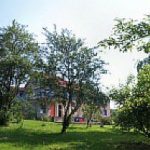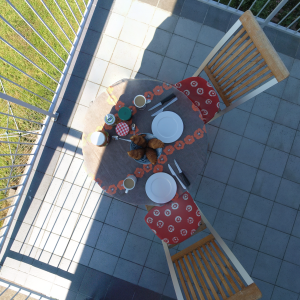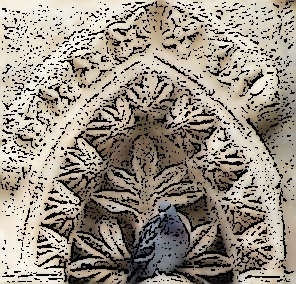To download a printable Adobe Acrobat version click on this link E2EYr8Weeks41-5.pdf (seven A4 pages)
Clicking on a photo will take you to a larger single image.
Clicking on one of the underlined links (e.g. food) will take you to a selection of photos.
Everyone has their own tale of volcanic ash and the disruption of travel plans. Ours began with a cookery book, Piri piri starfish: Portugal found, which Leila had given John. His bedtime reading of these recipes led to the idea of travelling to Portugal to sample authentic dishes for ourselves. Combine this with our love of train-travel and you can imagine the sequence: book a cheap Ryanair flight in April/early May from Baden-Baden to Porto, then a leisurely train journey round northern Portugal, sampling the wines and food. We would start by travelling up the Douro valley, with its spectacular scenery and branch off on the dramatic narrow-gauge railways up the Douro tributaries…
The plan was doomed from the start. First of all, research into train timetables showed that the narrow-gauge railways had got too dramatic, with fatal accidents, and were currently closed for essential work. And then of course, Iceland suffered a volcano crisis and flights began to be cancelled. We wondered whether we should postpone the trip (but then we’d miss the spring flowers) or drive down (a long journey, but the car would enable us to see more remote areas).
Late that Saturday afternoon, with planes still grounded, John returned with Bluto and a clean bill of health from the car’s obligatory controle technique (MOT equivalent), and we decided to cancel our Porto hotels, forget the train timetables, throw a few clothes in the back of the car, and start driving the following morning. Of course, although we included John’s computer and recent guide books to Portugal, we hadn’t updated our road maps for this trip, so we had a 2004 Michelin road atlas of France, a 2000 road atlas of Europe and our faithful (but already with out-of-date maps) satnav, Gladys. (At a service station we hastily purchased a Michelin map of Portugal). So we were soon struck by how new motorways have opened up swathes of rural France for rapid travel, in a way that the railways must once have done. Once out of Lorraine, we found ourselves careering through boar and deer forests towards Orleans on a motorway that wasn’t even a dotted line on our map book. The other shock was that the days of comfortable family hotels in every small French town seem to have vanished without us noticing, and we were reduced to finding a cheap hotel chain on some industrial estate near the airport on the outskirts of Poitiers (but at least there were no planes overhead).
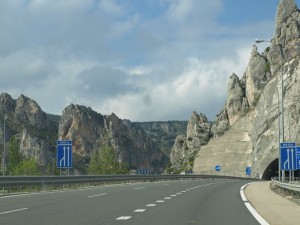
The road through the Pyrenees, Spain
The following day saw us crossing the border into Spain, between Bayonne and Bilbao, feeling as if the days of the highwaymen demanding every last coin had not vanished, as tolls were exacted every few kilometres. And then we lunged off down another splendid new motorway to Vitoria, with tunnels, soaring bridges, fantastic rock striations and stunning views.
On our third day, we decided it was time to slow down and appreciate a little of north-west Spain before crossing into Portugal, so we spent a morning in Salamanca, enjoying the old cathedral, elegant churches the huge Plaza Major with its outdoor cafés and young musicians in black doublets and hose. Then we drove on to the small hill-top walled town of Ciudad Rodrigo, on the Spanish side of the border. Our room in the Palacio Maldonado (lavishly refurbished downstairs and pleasant upstairs) overlooked the ramparts, a favoured route of dog-walkers, it seemed. But in place of cannons and attacking soldiers, sheep grazed peacefully between the defensive walls, and small black donkeys by the river. The fourteenth century castle, accustomed to withstanding the Moors, the Portuguese and Napoleon, had also lapsed into a more peaceful role as a Parador, and we decided to experience their “taste of the region” menu. By 10 o’clock, when we were ready for bed, the Spanish were just settling down to their food.
We crossed the border into Portugal the next morning. On the original plan, we’d have been in Porto, on the coast. This route felt like the back door into Portugal, – the scruffy route. The well-tended land on the Spanish side changed abruptly to wilderness. Once there had been fields with walls, and there must have been homes. But now it was abandoned. And then we reached the first hill-top fortifications on the Portuguese side – Almeida in its familiar Vauban star-shaped glory. Two vans with hunting horns painted on their sides hurtled through the gates to deliver the post to outlying areas.
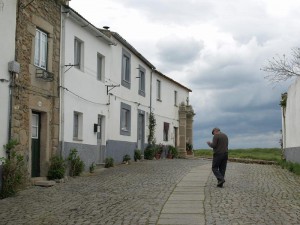
Almeida
It was a surprise, once we had walked through the impressive tunnelled gateways, to find that the village inside had the air of a Cornish fishing village, with its whitewashed walls and narrow streets. It had undergone a face-lift since the military finally left in 1928. I was particularly touched, as you can imagine, when I paused in front of the library, and was pushed enthusiastically inside by a passing inhabitant, who clearly thought it was one of the marvels of the town. It had been attractively renovated. It didn’t seem to have many books (though an old one was open in a showcase at an illustration of the fort at Agra) but the computers were all in use and chairs were being organised for a meeting or lecture. Down by the old barracks, the fire station was making its own preparations, with firemen busily washing their engines. The subterranean barracks had been turned into a museum with displays of different military periods. The pictures illustrating the Peninsular War all looked like stills from “Sharpe’s Gold”. However, listening to the commentary, it soon became obvious that Wellington’s victories against the French were due not to the fictional Sharpe and his small band, but to the outstanding Portuguese soldiers who Wellington always placed in the front of any attack. At lunch time, the small bar where we were still having coffee (after our leisurely breakfast discussing volcanic ash and alternative land and sea routes with an enterprising English couple) was popular with workmen who were served earthenware bowls of steaming food.
From Almeida we drove towards Foz Coa, enjoying the whites, purples and lavenders of the wild flowers as well as the vines, almonds, olives and freshly ploughed fields. We stopped in Castelo Melhor, and joined four congenial English people (who’d also had to make alternative travel plans) and a guide bouncing down a rutted track in an Archaeological Park landrover to some of the prehistoric rock carvings by the river. These are not in caves (like Lascaux) or under dramatic overhangs (as in the Drakensberg Mountains) but on separate bits of schist rock face, shorn off in places.

Rock carving at Castelo Melhor near Foz Coa
And, if they had been painted, there is no trace of paint now, just layers of overlaid scraped or chiselled lines. The guide was very good, tracing in the air all the lines we could so easily have overlooked. We examined six rocks out of the hundreds that have been found. They were noticed when a dam was being built, and all work on the dam has come to a halt since. We spent the night in a grumpy hotel in Foz Coa, dashing out in the torrential rain to the nearest restaurant. No sign of chicken piri-piri or hearty casseroles there, so John had good cod and fried potato and I had veal escalopes and chips, both accompanied by a rice and bean mix and a very heady wine.
With rain still threatening next morning we visited more prehistoric rock carvings by the river Coa at Canada Inferno, then headed towards the Douro. We were seduced by mention of ruins to detour along a cobbled narrow track between stone walls, which followed a contour and vineyards round the hillsides for several kilometres. Again the wild flowers were so pretty in the afternoon sunshine, and everything was fresh after last night’s rain. There were no houses and no people apart from some French walkers along this ancient-feeling route.
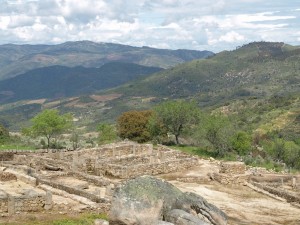
Roman ruins near Freixo de Numão
And then, below us we spotted ruined columns and walls. It was a spectacular site, in need of some explanatory panels, but appeared to be Roman, built on Neolithic remains.
As we dropped down from the mountains towards the River Douro, we were engulfed by more vine terraces, and could have drunk our way westwards at any of the great port names, (including Sandeman in his black cape). John had found on the internet a remote agrotourism hotel up in the hills for the night. It was so remote that it was hard to find (Gladys was a star here), and it was great to be welcomed on our arrival with a glass of port and the news that, as it was quiet, we’d been upgraded from a double room to our own stone cottage, with sitting room and small garden. As you can imagine, we can thoroughly recommend this new venture, with its enthusiastic young manager. Apparently his mother does all the cooking, but we never saw her enter or emerge from the kitchen. After a walk through orchards and vineyards and a bath, Mama’s locally-sourced food was served: starters of either succulent black sausage or bread sausage, followed by cod in corn bread or pork in a sweet and sour sauce, and a white wine from the days when it had been a farm. On the TV in the main sitting room Fulham was playing Hamburg, and we sank into the sofas to watch.
Next morning Mamma’s home-made pumpkin jam was delicious on the freshly delivered rolls, not to mention her chocolate cake. We headed off to Lamego for the day, but it was another diversion that proved the most enjoyable – to the Visigothic / Romanesque chapel of São Pedro de Balsemão (the oldest church in Portugal, we discovered later). We weren’t even sure that we’d found it at first, as from the side it looked a bit like a run-down factory with four-square stone walls. Rounding a corner we could see stone steps and a doorway with coats of arms. We were still uncertain, but once up the steps we were stunned to find ourselves in a small basilica with three naves, columns with Corinthian capitals, a coffered, painted, wooden seventeenth century ceiling, and a beautiful fourteenth century bishop’s tomb resting on recumbent lions.
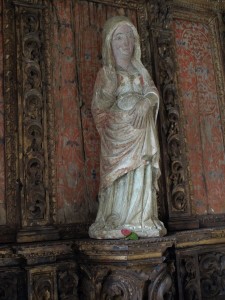
Pregnant Virgin Mary at São Pedro de Balsemão
A cheerful lady came bustling in from the courtyard on the other side, wiping her hands on an apron and pointing out all the “primitive” features and the fourteenth century Virgin of the O, the pregnant Virgin Mary. There were also fragments of Roman epigraphs incorporated into the walls, to add to the timeless feels of the little church. But then, alas, time intervened, for she was clearly anxious to serve the lunch she’d been preparing. So we drove on to Lamego and its castle, museum, churches and drab ladies’ and gents’ outfitters. But it was Balsamão that had captivated us. That evening Mama offered a choice between baked octopus and veal followed by strawberries or “pudding” (like a slice of thick crème caramel)
Having really enjoyed two nights of agrotourism, we decided to book another rural hotel, on the other side of the Douro, handy for Braga, the mediaeval town of Guimaraes and the fortified Celtic hill settlement of Breiteros. This hotel was even harder to find with just a name and place, but it seemed to be well known for miles around, as burly workmen in cafés drew us diagrams of how to get back on course and find it (road, town and street signs in rural Portugal are nearly non-existent and both Google maps and Gladys had identified only one place of the same name in the area, which turned out to be the wrong one). From the moment we reached its high walls and gate, we felt there was some mystery about it, which was perhaps well known to the locals. The man who greeted us had the air of a pirate, as he escorted us down the steps from the gate into a well-tended garden of fountains, box hedged paths, vine-covered terrace, red roses, azaleas, rhododendrons, pure white lilies, stone tables and white chairs.

Quinta de Santo Antonio do Pombal
Then his father appeared, and our pirate started to shuffle deferentially. Father struck John as a fallen aristo (and me as a wily lawyer). The odd duo showed us our cottage, which initially felt a bit damp, and then the main house with the sombre dining room for breakfast next morning. Clearly, promoting local foods is not part of their role, for no dinner was provided, and the nearest town of Fafe on a Sunday night was uninspiring. Over breakfast the next morning, father and son hovered in a menacing fashion, watching our every mouthful. It transpired that mother lives in Porto (in two houses), but father acquired this quinta twenty years ago, in some dodgy sounding deal where a friend first purchased but couldn’t afford it.
Father was determined that we should see a pilgrim church on a hill with a baroque staircase with fountains, but we were more keen to see the Celtic Citania de Briteiros. This is an amazing archaeological site. We’ve never seen such a vast hill settlement before, nor walls which rise two to three feet high. John suspected the nineteenth century archaeologists of rebuilding many of the walls, when we saw other areas which looked like undifferentiated rubble. We spent a long time there in the heat of the mid-day sun, and also enjoyed the small museum in the village, then drove on to Braga behind a car whose hobbit-sized owner had imbibed excessively. We strolled round Braga, rather overwhelmed by the exuberant jungle of carvings on the cathedral’s organ and the gilded balcony choir stalls. Appropriately, we dined at the Churrasqueira da Se (Cathedral Grill) on nibbles of fishcakes, olives and sausage slices, followed by salad, grilled meat and mounds of rice and chips (chicken piri piri is still proving elusive). The patron on his barstool was transfixed by the match between Braga and Naval (so we added to our scant knowledge of the Portuguese football league), but he leapt off his stool, yelling as Braga scored the first goal.
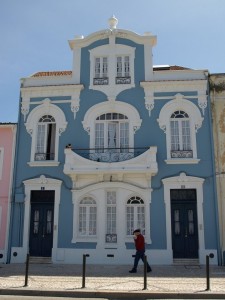
Art deco in Aveiro
Next morning, Father was anxious to be handed cash for the two nights’ “hospitality” before he left for Porto, and we were escorted from the gated premises by the pirate. We decided against trying to drive and park in Porto, but crossed back over the Douro outside Porto, stopped for coffee in the coastal town of Aveiro, with its art deco houses and colourful high-prowed boats, then headed south-east towards a night of extravagant pleasures at the Buçaco Palace Hotel (I’d pleaded an imminent birthday when John had expressed doubts). Like so many beautiful things, the walled forest in which the palace is situated, was created by monks. They planted hundreds of species of trees round their convent, as a reminder of Mount Carmel and a symbol of earthly paradise.
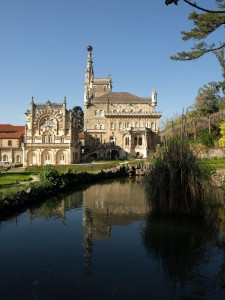
Palace Hotel do Bussaco (Buçaco), Coimbra, Portugal
The flat, dull countryside vanished as we plunged into this lush, hilly forest, with its follies, towers and neglected chapels (along a mossy Via Crucis). We were enclosed in another world – magical, contemplative, inviting. Beneath the soaring trees were streams with decadent white lilies, winding paths, steps, cascades, formal box-edged gardens, and a wisteria walk dripping mauve flowers. And then, plonked in the middle, next to the monks old chapel, was the neo-Manueline, icing-sugar, fantasy palace created at the end of the nineteenth and beginning of the twentieth century. It had the air of a maharaja’s palace, and indeed, some of the blue and white tile pictures inside depicted the Portuguese ruler of India, along with scenes from the battle of Buçaco in 1810 (in which Wellington’s army defeated the French after the Siege of Ciudad Rodrigo, the Battle of Coa, and the Siege of Almeida – had we unwittingly been following the French attack route?). The forest outside was romanticised inside in huge wall paintings of minstrels, ladies, and hunters in the smoking room-cum-bar, whilst the hallway was a riot of carved white Edinburgh rock.
That evening, after a forest walk and a lingering bath, we descended to a dining room which combined features of a large railway station buffet with those of a French château. Amid the array of starched linen, wine glasses and painted walls (sailing ships in misty seas), we ordered a splendid-sounding dinner. But with the wine list starting at 1,000 euro for a bottle red and 800 euro for white (as well as 3,600 euro for vintage port) and stopping at 40 euro, John pointedly ordered beer while I splashed out on an eight euro glass of indifferent white wine. With no chicken on the menu, my companion, as they say in reviews, chose a starter of suckling pig ravioli, giblets sauce and orange zest confit, followed it with a very fiddly-to-eat steamed ray wing with raspberry emulsion, bread pudding with tomato and green asparagus, and still had an appetite for grilled wild boar with garlic and rosemary sautéed potato with cider and rapini purée tartlet (though found the boar dry). I really enjoyed my more delicate suckling pig salad with pistachios, pine nuts and marinated figs in Douro Moscatel followed by gratinated scallop and sautéed tiger prawn with pennyroyal leek confit. When the dessert trolley rattled up, we both chose the tropical fruit tart and a slab of ice-cream with walnut, vanilla and red fruit.
Not surprisingly we slept heartily and woke to an equally sumptuous breakfast laid out on the central oval table. I couldn’t bring myself to start the day with chilled “champagne” or with a cooked breakfast, but loved the three-tiered fruit bowl in the centre and the candelabra of bowls of cereals, apricots and fruit salad and the ceramic hen on its boiled eggs. After we’d explored more of the dappled forest, we drove out of the enchanted forest and back onto the scrubby plain, and the Roman marvels at Conimbriga. It was a hot day, and the noisy school groups were as bothersome as flies. But we really enjoyed the ruins, with their spectacular mosaic floors.
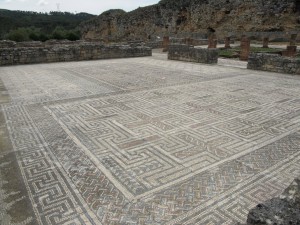
Conimbriga Roman ruins, near Coimbra, Portugal
But it wasn’t until one of the school groups put some money in a slot we had overlooked, that we got the full benefit of Roman engineering, as reconstructed fountains (or jets of water) all round the central garden of irises, began to spray water. Such a cooling sound. The underground heating of the baths was also impressive, though we weren’t so keen on the partial reconstruction of the forum. Behind the house of the fountains rose a later, enormous, defensive wall which cut right through the rows of Roman houses, but, alas, it had failed to keep out the barbarians. The museum was good and informative and its café was great for plum juice, peach juice and the most delicious sweet pastries.
From Roman Conimbriga we moved on to Portugal’s former Moorish stronghold and mediaeval capital Coimbra (and the incongruously named Hotel Oslo). As the day began to cool, we climbed up a great many steps from the Moorish gateway, past linen and ceramic shops, towards the old cathedral and the university at the top (and not until we reached the top did we spot the yellow trams on their alternative route). However the cool blue-and-white café part way up served some of the best (and cheapest) coffee and (on the way down) beer. The old Romanesque cathedral was lovely (we never made it to the new cathedral) and we lingered there before continuing up to the glories of the university’s 18th century Joanina Library (I had to get another library in).

Biblioteca Joanina (Dom João V Library) Coimbra
This reminded me of academic libraries I had worked in, with its galleries and step ladders. But nothing in my past matched the splendours (and gilding) of this Baroque library. And I had certainly never worked in a library where the bats were encouraged at night (after the tables had been covered over) to feed on any papyrophagus insects which might threaten the ancient volumes.
Back at the foot of the hill, we dined in a small family-run restaurant in a narrow street. The old man cooked, his wife kept popping out and returning with plastic bags, and a daughter waited cheerfully and briskly on a mix of students, locals and tourists. We were glad of the bread and salty sheep’s cheese as we waited for our goat in red wine to cook. Here a carafe of good house red wine cost four euro (a bit of a contrast with the previous night’s prices).
If you’ve read so far, you’ll have shared some of our impressions of Portugal’s Palaeolithic, Roman, Celtic, Visigothic, Moorish, Romanesque, Manueline, Napoleonic and neo-Manueline cultures. As our journey neared its end we wanted to spend the next day seeing something of the Knights Templar and the Jewish community at Tomar. Tomar’s small restored mediaeval synagogue was in an small house at the foot of the hill which had been used as a prison, a barn and a warehouse after the Jews were forced in 1496 to convert or flee Portugal. Now there are not enough Jewish men for a Torah service to be held (the quorum being ten), and it has become a museum. Round the wall are moving letters and cultural gifts from Jewish visitors from around the world.
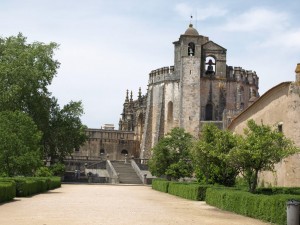
Castle and Convent of the Order of Christ-Knights Templar, Tomar
By contrast, the Knights Templar Convento de Cristo up on the hill is an enormous, rambling statement of power. This monastic fortress with its crenellated walls to repel the Moors, dominates the town. The vows of poverty of the Knights Templar were not much in evidence as we wandered from one magnificent cloister to another and into the opulently decorated round church and ambulatory (did the KTs really ride their horses there?), the choir (its stalls missing after the Napoleonic troops woz ‘ere), and out again to look at facades dripping with sculpted symbols of maritime power. The T-shaped dormitory corridors at the far end were long, dark and sinister-feeling, with the arching aqueduct outside. After that I began to lose all sense of direction as we followed lower corridors, through the refectory, kitchens (which smelt of recent smoke), stables, a store-room for olive oil and firewood and another containing unlabelled mosaics and a sundial. Children’s screams and laughter could be heard at one point and people emerged from private doorways and disappeared up corridors. An ideally mysterious setting for the occasional five hour performances (with five meal breaks) of Umberto Eco’s “The Name of the Rose.” We spent that night in Constancia, and ate in a blue-tiled tapas bar (veal for me and cod for John, so little change there) watching Inter Milan versus Barcelona. The bar customers seem happy that the Italian team, no doubt due to the leadership of their José Mourinho, beat the Spanish.
Next day we saw more castles, including Almourol on its island, complete with ferryman, before reaching the border town of Castelo de Vide. There we wandered through the attractive old town, with its fountain, flowers and cats. Both the synagogue and castle were closed, by then, but maybe we’d seen enough castles for the day. So we sloped off for a beer in the late afternoon sunshine. To our surprise chicken was on the bar’s menu of the day. What better place for our last dinner in Portugal? When we returned later for soup, chicken in beer (it came, as usual, with chips and rice) and chocolate mousse, a baby was the focus of the tiny room, being passed noisily round the staff so that its harassed parents could tackle their splendid-looking skewers of prawns and chicken. Above, on the small screen, Liverpool were losing in extra time to Atletico Madrid. Our hotel that night was a former girls’ school, fully-booked by cyclists and their supporters for the following night (the next town was hosting a big cycle race). Internet comments had mentioned cramped bathrooms, so we shouldn’t have been surprised that it proved impossible to sit on the loo other than side-saddle (to avoid the sides of the small bath and large bidet-thing).
We visited the Friday market (clothes, hardware and cowbells outside, local produce inside) before leaving next day, then set out for home. We stayed in Ciudad Rodrigo again (same room even), looked round Zamora’s cathedral and castle, had a night in the Holiday Inn outside Vitoria, then decided to take a different route back through France. We had both been thinking nostalgically of our honeymoon camping trip round central France. It was a mistake to think we could recapture the old magic. The Puy de Dome looked great from a distance (and at least there was no volcanic ash), but somebody had moved all the streets of our favourite village from how we remembered them and its magical Café du Centre was closed. Tournus cathedral was somehow less atmospheric and we couldn’t find a decent coffee. And the little hilltop village of Brancion, with a Romanesque church, had been “restored” into a medieval theme park whilst the church’s amazing frescoes had been allowed to deteriorate. Then Bluto got a puncture and we couldn’t get the wheel off to put on the spare and I ended up with diarrhoea. So much for nostalgia. However, we had thoroughly enjoyed our first impressions of northern Portugal. We just need to remember – we’ll never be able to return to Portugal and have the same experiences again (although we might find chicken piri-piri).
(And, in case you hadn’t realised, the food link at the top takes you to the photos of our meals)
Photographs
Zamora
Castel de Vide
Tomar
JoaninaLibrary, Coimbra
Conimbriga Roman ruins
Buçaco Palace Hotel (neo-Manueline)
Bussaco Forest near Coimbra (panorama)
Citania de Briteiros (iron age)
São Pedro de Balsemão Visigothic chapel
Rock carvings of the Foz Coa valley
Almeida
Salamanca
Cathedral Vieja (Old Cathedral), Salamanca (panorama)
Ciudad Rodrigo (Spain)
St Philibert Romanesque Church, Tournus, France (panorama)






